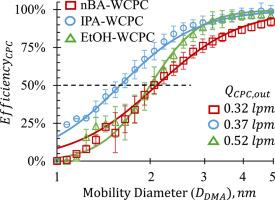凝结粒子计数器(CPC)中C2-C4醇和水的同时过饱和,以测量小于3nm的自然带电火焰形成的碳质气溶胶
IF 2.9
3区 环境科学与生态学
Q2 ENGINEERING, CHEMICAL
引用次数: 0
摘要
燃烧排放影响空气污染,开发先进的工具来检测和监测越来越小的火焰形成的气溶胶,对于实施更有效的空气质量法规和减少燃烧应用对环境的影响至关重要。冷凝粒子计数器(cpc)可以检测极低数量浓度的带电和中性气溶胶,由于其相对便携性,可负担性和操作简单,在大气计量中广泛使用。尽管如此,它们的检测效率受到要检测的气溶胶的大小、电荷状态和形态的影响,以及它们的组成,这影响了它们被冷凝流体润湿性。因此,有必要进行校准,以表征CPC的检测效率,特别是对于小于3nm的火焰形成的碳质气溶胶,这些气溶胶可能具有相当多的分散成分和性质。在本研究中,双组分(流体-水)CPC由水CPC (WCPC)与饱和器入口耦合而成,该入口由正丁醇(nBA)、异丙醇(IPA)或乙醇(EtOH)操作,用于检测在早期煤烟预混火焰中形成的自然带电的碳质气溶胶。Khosravi et al.(2023)用二甘醇(DEG)操作饱和器入口,并表明水和DEG(即任何含有Le >的流体)同时过饱和;1)建立的DEG-WCPC(即任何流体- wcpc)增强了对小于3nm的物质的检测。本文的研究结果表明,nBA-WCPC、IPA-WCPC和EtOH-WCP不仅在以50%的效率检测最小尺寸方面具有相当甚至更好的性能(当然在IPA-WCPC的情况下),而且与DEG-WCPC相比,清洗光学元件的需求最少,与成分无关,与尺寸相关的检测效率曲线更陡峭。即使在饱和器进口中使用测试的C2-C4醇,CPC级的长度尚未优化,情况也是如此。特别值得一提的是,EtOH作为高性能CPC工作液的使用是同类中第一次,EtOH- wcpc已经实现了最陡的检测效率曲线,这一特性对需要尺寸分辨率的研究具有吸引力,并且具有最大的性能改进空间。本文章由计算机程序翻译,如有差异,请以英文原文为准。

Concurrent supersaturation of C2-C4 alcohols and water in a Condensation Particle Counter (CPC) to measure naturally charged flame-formed carbonaceous aerosols smaller than 3 nm
Combustion emissions impact air pollution, and the development of advanced tools to detect and monitor increasingly smaller flame-formed aerosols is vital for implementing ever-more effective air-quality regulations and reducing the environmental impact of combustion applications. Condensation Particle Counters (CPCs) can detect both charged and neutral aerosols in very low number concentrations and are of widespread use in atmospheric metrology thanks to their relative portability, affordability, and simplicity of operation. Still, their detection efficiency is influenced by the size, charge state, and morphology of the aerosols to be detected, in addition to their composition, which influences their wettability by the condensing fluid(s). As a result, calibrations are necessary to characterize the detection efficiency of a CPC, especially for flame-formed carbonaceous aerosols smaller than 3 nm, which can have quite polydisperse composition and properties. In this study, two-component (fluid-Water) CPCs resulting from coupling a Water CPC (WCPC) with a saturator inlet operated with either n-butanol (nBA), iso-propanol (IPA), or ethanol (EtOH) are characterized for the detection of naturally charged carbonaceous aerosols formed in an incipiently sooting premixed flame. Khosravi et al. (2023) operated the saturator inlet with Diethylene Glycol (DEG) and showed that the concurrent supersaturations of water and DEG (i.e., any fluid with Le > 1) established in the DEG-WCPC (i.e., any fluid-WCPC) enhance the detection of materials smaller than 3 nm. The results herein demonstrate that the nBA-WCPC, the IPA-WCPC, and the EtOH-WCP have not only comparable or even superior (surely in the case of the IPA-WCPC) performances in terms of the minimum sizes detectable with 50 % efficiency but also the advantages of minimal needs for cleaning the optics and composition-independent and steeper profiles of the size-dependent detection efficiency compared to the DEG-WCPC. This is the case even though the lengths of the CPC stages have not been optimized yet for using the tested C2-C4 alcohols in the saturator inlet. In particular, the use of EtOH as a performant CPC working fluid is the first-of-a-kind, with the EtOH-WCPC already achieving the steepest detection efficiency profiles, a feature attractive for studies requiring sizing resolution, and having the largest room for performance improvements.
求助全文
通过发布文献求助,成功后即可免费获取论文全文。
去求助
来源期刊

Journal of Aerosol Science
环境科学-工程:化工
CiteScore
8.80
自引率
8.90%
发文量
127
审稿时长
35 days
期刊介绍:
Founded in 1970, the Journal of Aerosol Science considers itself the prime vehicle for the publication of original work as well as reviews related to fundamental and applied aerosol research, as well as aerosol instrumentation. Its content is directed at scientists working in engineering disciplines, as well as physics, chemistry, and environmental sciences.
The editors welcome submissions of papers describing recent experimental, numerical, and theoretical research related to the following topics:
1. Fundamental Aerosol Science.
2. Applied Aerosol Science.
3. Instrumentation & Measurement Methods.
 求助内容:
求助内容: 应助结果提醒方式:
应助结果提醒方式:


